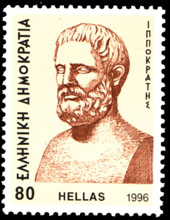 The Eber's Papyrus from ancient Egypt
was regarded as the oldest medical textbook. The symptoms and treatment
of diabetes were mentioned in the book. The page shown on this stamp relates
to the symptoms of polyuria and its treatment.
The Eber's Papyrus from ancient Egypt
was regarded as the oldest medical textbook. The symptoms and treatment
of diabetes were mentioned in the book. The page shown on this stamp relates
to the symptoms of polyuria and its treatment. 
 The Vedic scripture is a record of ancient
Hindu medicine. Diabetes was described as a disease characterized by sweet
tasting polyuria that attracts ants and flies and the development of gangrenes
and recurrent infections in the sufferers.
The Vedic scripture is a record of ancient
Hindu medicine. Diabetes was described as a disease characterized by sweet
tasting polyuria that attracts ants and flies and the development of gangrenes
and recurrent infections in the sufferers.
1. Prevalence of retinopathy
Diabetic retinopathy is the commonest cause of blindness in the
population of working age in developed nations and is of increasing
importance in developing nations2,3. The prevalence of retinopathy
varies with the age of onset of diabetes and the duration of the
disease: in younger patients (below 30 years of age) the prevalence
of retinopathy is minimal during the first 5 years but increases to
greater than 95% after 15 years of diabetes4. in contrast, in patients
whose onset of diabetes occurs after the age of 30, up to 20% may
have signs of retinopathy on presentation with the prevalence in this
group rising more slowly to approach 60% after 15 years of diabetes5.
.
In an insulin-treated subset of older-onset (>30 years) diabetic
patients, 30% have signs of retinopathy at diagnosis, rising to over
80% after 25 years of diabetes. More recent data on patients with
non-insulin dependent diabetes mellitus (NIDDM) as part of the
UK Prospective Diabetes Survey (UKPDS) indicate that the prevalence
of retinopathy at diagnosis is 38%, using a single microaneurysm as
evidence of retinopathy6.
.
As a general statement, therefore, the prevalence of DR of any
severity in the diabetic population as a whole is approximately 30%7.
.
1.2 Prevalence of sight-threatening retinopathy
Most cases of DR are non-sight threatening. However, the pre-
valence of progressive retinopathy with risk of visual impairment is
approximately 10%8.
.
Accurate figures for the prevalence of blindness (defined as
VA <3/60 in the better eye) in the UK are not yet available. In the
Wisconsin epidemiologic studies, the prevalence of proliferative
retinopathy was 60% after 25 years of diabetes in younger diabetic
patients, but in older diabetics it varied from 20 to 30% depending
on whether they were insulin-treated or not. In contrast, diabetic
macular oedema in 11% of younger diabetics and in 4% to 7% of
older depending on their insulin requirement. Despite the lower
overall rate of sight-threatening retinopathy in older patients, the
prevalence of visual disability is greater in this group due to the much
larger numbers of patients with NIDDM9. More recent data has shown
that the incidence of macular oedema over a 10 year period was 20%
in young diabetics, 25% in older age diabetics taking insulin and 14%
in non-insulin-taking older diabetics. In addition, there appeared to be
a correlation between incidence of macular oedema and poor diabetic
control (see later)10.
.
The prevalence of blindness due to DR has thus been estimated to be
approximately 5% (range 3-7%)11 and may be as high as 8%1. The
annual incidence of new cases of sight-threatening retinopathy in
the UK has been estimated to be approximately 1.2% of diabetics12.
In order to eliminate this, screening programmes aimed a the diabetic
population at risk of sight-threatening retinopathy, are presently being
developed. Pilot studies indicate that 2.5-3% per annum of the screened
population would require referral to an ophthalmologist.